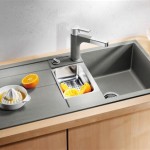How to Unclog a Kitchen Sink Garbage Disposal
A clogged kitchen sink garbage disposal can disrupt daily routines and lead to unpleasant odors. Understanding the causes of clogs and knowing how to address them effectively is essential for maintaining a functional and hygienic kitchen. This article provides a comprehensive guide to identifying and resolving common garbage disposal clogs.
One of the first steps involves determining if the garbage disposal is actually the source of the clog. A blockage further down the drainpipe may present similar symptoms. If water is backing up in both sinks, the problem likely lies beyond the disposal unit itself, requiring attention to the main drain line. If the issue is isolated to the sink with the disposal, the troubleshooting process can begin.
Safety is paramount when working with electrical appliances and potentially sharp objects. Before commencing any troubleshooting or repair work, the first and most crucial step is to disconnect the power supply to the garbage disposal. This is typically done by turning off the circuit breaker that controls the disposal unit. Confirm the power is off by attempting to turn on the disposal switch; if the unit remains inactive, the power is successfully disconnected.
Once the power is off, a visual inspection of the disposal unit is necessary. Look inside the disposal chamber with a flashlight. Attempt to identify any large, obvious obstructions, such as silverware, bones, fruit pits, or other non-food items that might be causing the blockage. Remove any visible objects using tongs or pliers. Never reach into the disposal unit with bare hands, even with the power disconnected, as sharp blades may still pose a risk.
Addressing Common Causes of Garbage Disposal Clogs
Several factors contribute to garbage disposal clogs. One of the most frequent causes is the improper disposal of certain food items. Stringy vegetables, such as celery and asparagus, can wrap around the grinding components, hindering their function. Starchy foods, like pasta and rice, tend to expand in water and create a paste-like substance that can block the drain. Grease, fats, and oils congeal as they cool, adhering to the disposal walls and pipes, eventually leading to significant blockages.
Another common issue is overloading the disposal unit. Attempting to grind too much food waste at once can overwhelm the motor and cause a temporary or permanent jam. It is best to introduce food scraps gradually, allowing the disposal to process them efficiently. Furthermore, insufficient water flow during operation can contribute to clogs. Water helps to flush food particles through the drainpipe and prevent them from accumulating.
Older disposal units may also experience clogs due to wear and tear. Over time, the grinding components can become dull or damaged, reducing their effectiveness in breaking down food waste. Mineral buildup from hard water can also accumulate on the disposal walls and blades, hindering performance and increasing the likelihood of clogs.
To prevent future clogs, it is advisable to adhere to a strict disposal protocol. Avoid putting problematic items into the disposal unit. Scrape food scraps into the trash or compost bin instead. When using the garbage disposal, always run cold water before, during, and after grinding food waste. This helps to solidify grease and fats, allowing them to be flushed through the drain more easily. Periodically clean the disposal unit to remove accumulated debris and prevent odors.
Using Tools to Clear a Clogged Garbage Disposal
If a visual inspection and removal of obvious obstructions fail to resolve the clog, more advanced troubleshooting methods may be required. Several tools can be employed to dislodge stubborn blockages. A common tool is a pair of tongs or pliers, which can be used to carefully remove any remaining debris from the disposal chamber. Avoid using metal objects that could damage the disposal blades or motor.
Another helpful tool is a specialized garbage disposal wrench or Allen wrench. Most garbage disposals have a reset button located on the bottom of the unit. If the motor is humming but the blades are not turning, the disposal may be jammed. Insert the wrench into the center of the bottom of the disposal and manually rotate the motor shaft back and forth to dislodge any obstructions that are preventing it from operating. After manually rotating the shaft, press the reset button to restore power to the unit.
A plunger can also be an effective tool for clearing a clogged garbage disposal. Before using a plunger, remove the rubber splash guard covering the disposal opening. Create a tight seal around the drain opening with the plunger and vigorously plunge up and down several times. The pressure created by the plunger can help to dislodge the clog and force it through the drainpipe. If the sink has a second drain opening, seal it off with a wet rag to ensure proper suction.
If the above methods prove unsuccessful, a bent wire hanger or a plumber's snake can be used to reach further down the drainpipe and break up or retrieve the clog. Exercise caution when using these tools to avoid damaging the disposal blades or the drainpipe. Gently insert the wire hanger or snake into the drain opening and carefully probe around to locate the obstruction. Once located, try to break up the clog or pull it out of the drainpipe.
After attempting to clear the clog with various tools, flush the disposal with plenty of hot water to ensure that all debris has been removed. Run the disposal briefly to test its functionality. If the disposal still does not function properly, repeat the troubleshooting steps or consider seeking professional assistance.
Alternative Methods for Unclogging a Garbage Disposal
In addition to the methods described above, several alternative approaches can be used to unclog a garbage disposal. These methods often involve using household ingredients to break down the clog. One popular method involves using baking soda and vinegar. Pour one cup of baking soda followed by one cup of vinegar down the drain. Allow the mixture to fizz for approximately 30 minutes, then flush with hot water. The chemical reaction between the baking soda and vinegar can help to dissolve grease and other debris that are causing the clog.
Another alternative method involves using boiling water. Carefully pour a pot of boiling water down the drain. The hot water can help to melt grease and dislodge other materials that are contributing to the clog. Exercise caution when pouring boiling water to avoid scalding or damaging the drainpipe. This method is particularly effective for clogs caused by grease and fats.
Another technique involves using ice cubes and salt. Pour a tray of ice cubes and one cup of salt down the drain. Run cold water and turn on the disposal. The ice cubes and salt act as abrasive agents, helping to scrub the disposal chamber and dislodge debris from the walls and blades. This method can also help to sharpen the disposal blades and improve their overall performance.
Enzyme-based drain cleaners are another option for unclogging a garbage disposal. These cleaners contain enzymes that break down organic matter, such as food waste and grease. Follow the instructions on the product label carefully. Avoid using chemical drain cleaners that contain harsh chemicals, as they can damage the disposal unit and the drainpipes. Enzyme-based cleaners are generally considered to be a safer and more environmentally friendly alternative.
Preventive maintenance is crucial for keeping a garbage disposal in good working order. Regular cleaning and proper usage habits can significantly reduce the likelihood of clogs. Flush the disposal with hot water and a mild dish soap after each use. Grind a few ice cubes with salt periodically to clean the disposal chamber and sharpen the blades. Avoid disposing of problematic items and always run plenty of water when using the disposal.
If all troubleshooting methods fail to clear the clog, it may be necessary to seek professional assistance from a plumber. A plumber has specialized tools and expertise to diagnose and resolve more complex clogs. Furthermore, attempting to disassemble the garbage disposal unit without proper knowledge can lead to damage and void the warranty. A professional plumber can safely and effectively resolve the clog and ensure that the disposal unit is functioning properly.
Properly maintaining a kitchen sink garbage disposal requires understanding the potential causes of clogs and implementing preventive measures. Regular cleaning, proper disposal habits, and timely intervention can help to keep the disposal unit functioning efficiently and prevent costly repairs.

Clogged Kitchen Sink With Garbage Disposal How To Solve Quickly 3 Easy Fixes By Diynate

How To Fix A Clogged Kitchen Sink On Both Sides

How Do I Unclog A Garbage Disposal Westlake Ace Hardware

4 Easy Ways To Unclog A Kitchen Sink With Garbage Disposal

How To Unclog A Garbage Disposal Diy Guide Affresh Appliance Care

4 Ways To Unclog A Garbage Disposal Wikihow Life

How To Unclog A Garbage Disposal Diy Guide Affresh Appliance Care

How To Unclog A Garbage Disposal Diy Guide Affresh Appliance Care

How To Unclog A Double Kitchen Sink 1 Tom Plumber

How To Unclog A Kitchen Sink Family Handyman







